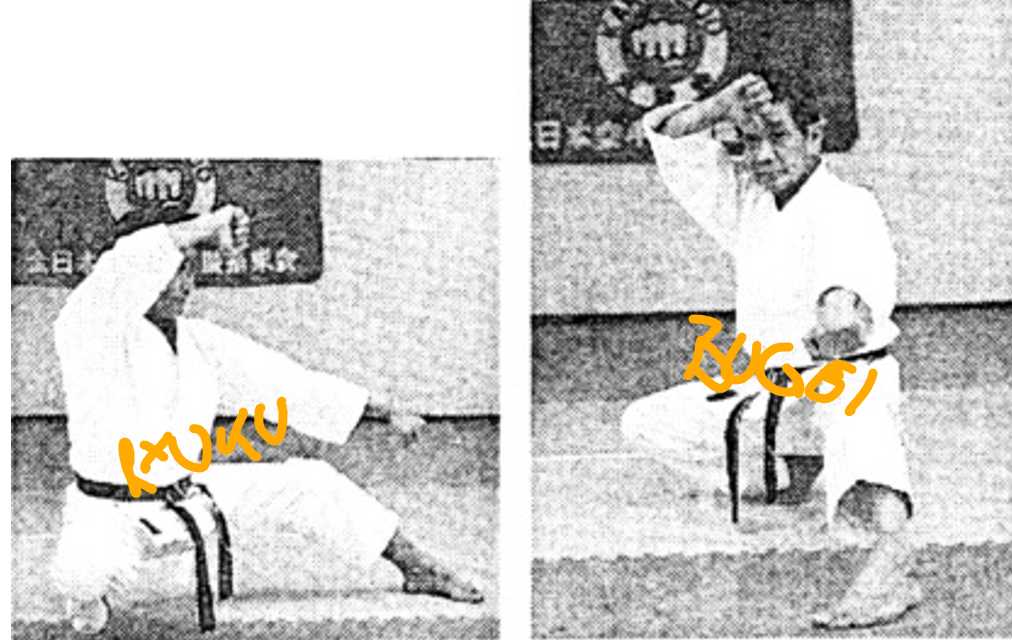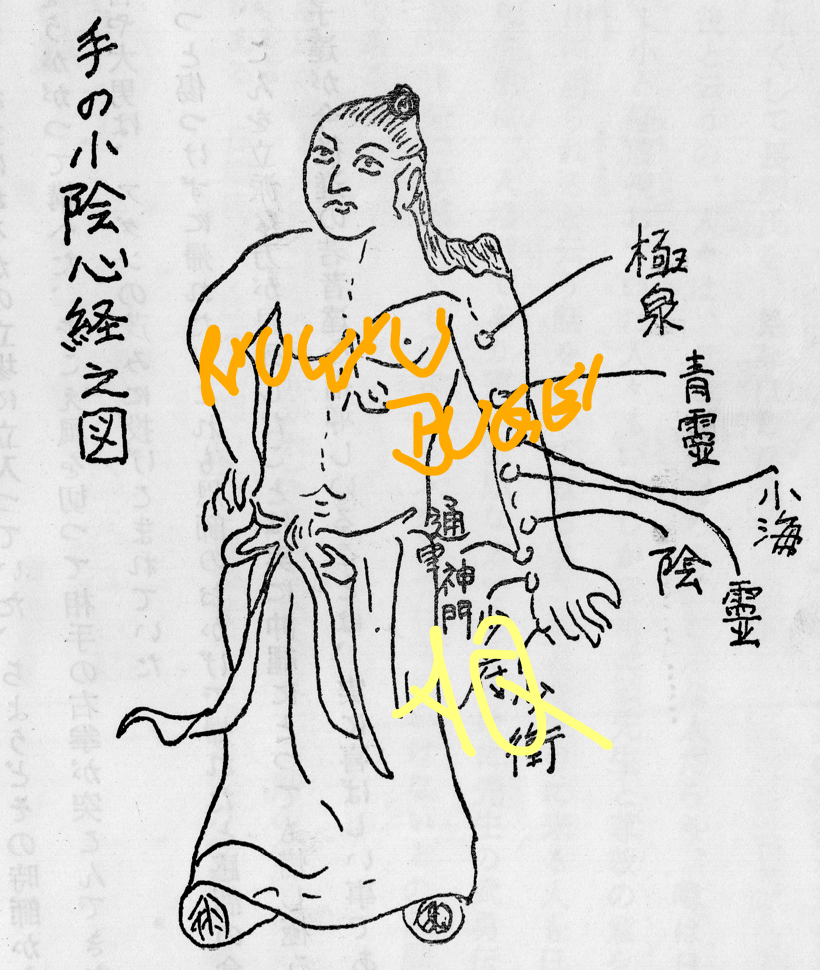In Okinawa karate theory and history, there is a train of thought that connects the persons Kūsankū, Sakugawa, and Matsumura Sōkon in sense of an unbroken personal tradition of skill, or of a teacher-student relationship. Like this, you will find genealogies such as Sakugawa à Matsumura à Itosu à modern Shurite.
How did this idea develop and is there any proof for it?
First, there s no karate kata bearing the name of Sakugawa. There is a bōjutsu kata by the name of Sakugawa. This bōjutsu kata includes a half-kneeling posture that is quite similar to the same posture in various versions of Kūsankū kata. There are also other bōjutsu kata that include the same posture, such as Chatan Yara no Kon. This similarity in postures might be reason for people to believe that there must have been a personal relation, or a master-student relationship between Kūsankū and Sakugawa, or Kūsankū and Chatan Yara, or both.
Of course, it would be nice for the historical claims of Okinawa Karate if a direct personal transmission of the technique from master to student could be established in this way. However, so far, it seems to be just a postwar story and largely a supposition without any proof or even hints. It is characteristic of Okinawa Karate that one does not comment on problems that could question and jeopardize the foundations of their own “Okinawa Karate theory”.
Let’s look at a theory by one of the greatest Okinawa Karate researchers of all times, Kinjō Hiroshi Sensei. Kinjō is an Okinawa. Born and raised in Shuri, he learned karate since his youth. In the postwar era, he published karate magazines and researched the history and techniques of Okinawa Karate all his life. In his last work, which is of eminent importance for modern karate research, he presents the story how he finally discovered the evidence for the master-student relationship between Sakugawa and Matsumura. The following is a translation of his reasoning.
Tōdī Sakugawa and his relation to Matsumura Sōkon
Wanting to know a little more about Tōdī Sakugawa, I examined the name register of the Ryūkyū royal government, but the name Sakugawa was not to be found in it. Maybe his Chinese-style name was used. However, as regards the fact that he studied in China, it was found that he traveled to China more than once as a member of the entourages of Ryūkyūan tribute missions. Within my various investigations, I made a great discovery. That is, the fact that Matsumura Sōkon – who might also be called Ryūkyū’s unparalleled Saint of Boxing – has been a disciple of Sakugawa Kanga.
Here, themartial artsgenealogy of karate originator Itosu Ankō in a straight line leads from China to Sakugawa, from Sakugawa to Matsumura, and to Itosu. Of course, this doesn’t mean that only Chinese kenpō of Sakugawa Kanga would have existed in the town of Shuri. Besides Sakugawa’s Chinese kenpō, it is indispensable to also consider earlier kenpō that has had already become Ryūkyū-ized “tī”.
I would now like to write about details of the teacher-student relationship between Sakugawa Kanga and Matsumura Sōkon. While researching Sakugawa Kanga, I was able to catch sight of the theory that Sakugawa died abroad in Beijing, was buried at the foreign cemetery located outside of Beijing, and in later years his mortal remains were returned to his native land of Ryūkyū by the hands of Matsumura Sōkon. According to the tradition of folk belief of Ryūkyū, if a person comes into physical contact with the mortal remains of a deceased person who was not a blood relative, that person will enter a time of terrible misfortune. Even today this kind of superstition of our regional character remains.
That is, I hypothesize that because one hundred and seventy years ago Matsumura, who was not a blood relative of Sakugawa, brought back Sakugawa’s mortal remains, there must have undoubtedly been a deep teacher-student relationship between the two, isn’t it so?
If this hypothesis would be proven, I thought that the martial art of Itosu Ankō, the inventor of “school karate,” is linked in a single straight line to Matsumura and further to Sakugawa, and therefore, it is also linked to Chinese kenpō of Beijing. Both Sakugawa and Matsumura studied Chinese kenpō in Beijing. However, the story that both were in a master-student relationship has never been heard.
I was lost in thought, wondering if the hypothesis of a master-student relationship between Sakugawa and Matsumura would end up being just a hypothetical problem without any chance of proving it.
Accidentally, I received a letter and a copy of an illustration from Miyagi Tokumasa. By means of this letter and illustration, I was able to prove the teacher-student relationship of Matsumura and Sakugawa.
Thanks to the support of Miyagi Tokumasa (1939–), the hypothesis of a master-student relationship between Sakugawa and Matsumura has been demonstrated. However, the fact that I wasn’t able to demonstrate the hypothesis by myself, but only by borrowing the support of another authority, is indeed ironic. Furthermore, in later years, by a record of Sakukawa’s funerary urn, it was found that the theory of Sakugawa dying abroad in Beijing turned out to be mere rumor, a glamorizing fable.
By substantiating the teacher-student relationship of Sakugawa and Matsumura, karate for school education becomes a genealogy leading from Beijing → to Sakukawa → to Matsumura → to Itosu, and can be understood as what became the “tī” of the age of Matsumura.
This “tī”, which molted from the Chinese kenpō of Matsumura, represents an extremely important point within the history of karate technique. Because without the existence of Matsumura’s “tī”, the creation of “school karate” would have been impossible. Nonetheless, it should not be forgotten that besides Matsumura many masters and experts of tōdī or ti, respectively, were also variously active.
Illustration: This is one sheet of a booklet about atemi and ukemi (striking of and receiving with the body), originally bound from 16 sheets in total and presented to Matsumura Sōkon by Tōdī Sakugawa. The original booklet was lost during World War II. Only this one sheet remains as a copy (provided by Miyagi Tokumasa).
Translator’s addendum
It took me a number of years to locate the original source of the diagram. In fact, it was only when I went to Okinawa and met colleague and friend John Lohde, who brought along the extremely rare original source. I described the drawing here.
Here are some points to consider:
- According to Miyagi Tokumasa, around 1995 it was still not confirmed whether the meridian diagram really belonged to an original of 16 bound papers, and whether these were really given by Tōdī Sakugawa to Matsumura Sōkon and then handed down by someone. However, the theory was “tentatively accepted.”
- Is there any ongoing research of the theory?
- Such meridian charts have been available anywhere since the Ming era, and always look the same. What qualifies it as an atemi chart?
- While there are esoteric kyusho methods that use meridian theory, atemi waza uses many specific points and body regions not defined by esoteric meridian theory. Why would anyone use such an impractical method?
© 2023, Andreas Quast. All rights reserved.


